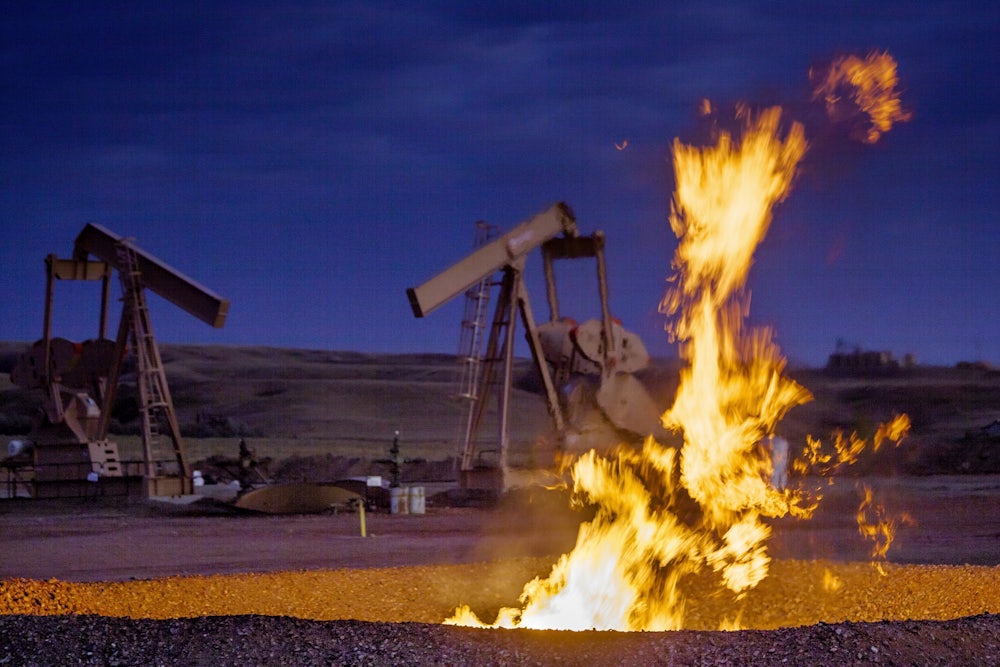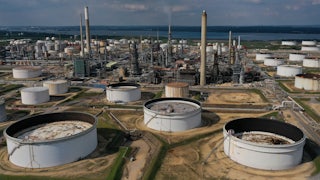Countries and corporations like pledging to reduce methane—in part because reducing methane emissions seems like low-hanging fruit: You can cut a lot just by reducing leaks and excess flaring from drilling sites and refineries. As part of the Global Methane Pledge—instigated by the United States and the EU in 2021—150 countries pledged to cut methane emissions by 30 percent below 2020 levels by 2030. But a new report from the environmental data firm Kayross, analyzing satellite imagery, recently found that methane emissions from nine fossil fuel basins had increased 7 percent above 2020 levels. The U.S. ranks among that study’s “worst performers,” buoyed by surging oil and gas production. We’re currently the world’s third-largest source of methane emissions after China and India.
America’s methane problem has been mostly absent from campaign trail debates about fracking, focused on the swing state of Pennsylvania. Former President Trump has claimed his opponent, Vice President Harris, wants to ban fracking, while Harris has countered that not only does she support the practice but that her tie-breaking vote on the Inflation Reduction Act opened up new fracking opportunities.
The Biden-Harris administration, that is, has mostly stuck to the long-standing Democratic Party line: that there’s no contradiction between reducing emissions to meet climate targets and boosting domestic fossil fuel production. That stance is premised largely on the idea that the oil and gas industry will clean up its act, using funds provided through the Inflation Reduction Act to develop technologies to draw down excess carbon emissions and stop methane leakage. Yet mounting evidence from the past month suggests the oil and gas industry will do no such thing. As tech companies’ power-hungry A.I. data centers fuel a new building binge for gas-fired power plants, corporate pledges to reduce emissions have never looked flimsier.
At least two-thirds of global methane emissions are now produced by human activity, as opposed to ambient sources like wetlands. Much of that comes from agriculture; animal agriculture is an especially large contributor. But worldwide, fossil fuel production is responsible for about half as many methane emissions as food production—which is still a hell of a lot of methane. Because methane isn’t emitted by the combustion of oil and gas, energy producers have long made the case that they can easily get their methane emissions under control by patching leaks from pipelines and storage facilities and curbing routine practices like venting and flaring, which are used to release methane companies can’t sell into the atmosphere. During last year’s U.N. climate talks, 50 oil and gas producers—including some of the world’s largest private and state-owned producers—pledged to curb their methane emissions to “near zero” by the end of this decade. The United Nations Environment Program’s International Methane Emissions Observatory, or IMEO, the International Energy Agency, and the Environmental Defense Fund, or EDF, all vowed to help companies meet those goals.
This week, the EDF—which has been helping to monitor methane emissions using planes outfitted with special cameras designed to detect methane—found that progress has been slow. EDF imaging and modeling shows that drillers in the continental U.S. have been releasing up to four times as much methane as they’ve reported to federal regulators. Under the methane pledge oil and gas producers signed, “near-zero” methane emissions are defined as a 0.2 percent “loss rate.” In other words, the target would be to release only 0.2 percent or less of the total volume of methane that’s produced as emissions. The Appalachian Basin, which includes large parts of Pennsylvania and Ohio, has the country’s highest loss rates, at nearly 1 percent.
Companies that talk a big game about reducing methane emissions have also resisted efforts to reduce emissions. Earlier this month, a Trump-appointed judge in Texas blocked the Interior Department from enforcing new regulations on methane emissions in five Western states (North Dakota, Texas, Utah, Montana, and Wyoming) that are suing the federal government over the rule. The rule sets limits on how much methane companies can vent or burn off, and charges them royalties on “wasted” methane.
All this comes as U.S. energy providers plan to build more gas-fired power plants than they have in years. As Bloomberg reported this week, that boom is due to Silicon Valley’s rush to build energy-intensive data centers to power their A.I. ventures, as well as new investments in manufacturing—including electric vehicle manufacturing. The boom in gas-fired plants threatens not just to encourage more production from America’s leaky oil and gas fields but also to keep carbon dioxide–emitting gas-powered generation online for decades to come; such plants typically stay open for 40 years or more. Tech companies have been quick to wave off these complaints, promising that their investments in renewable energy and carbon capture and storage will lead the way on decarbonizing the grid; some tech executives have also claimed A.I. itself is indispensable to fighting the climate crisis.
Anyone familiar with the fossil fuel industry’s track record on their climate pledges should know better than to take tech billionaires at their word. After years of preaching that self-regulation and investments in low-carbon technologies would put them on the path to net-zero, oil and gas companies are drilling—and emitting, and lobbying—more than ever. Tech firms won’t be any different. Whatever Harris says on the campaign trail about all this, though, matters less than what she might do in office; her tenure in the White House so far hasn’t inspired much confidence. Continuing to let both fossil fuel and tech giants off the hook for ballooning emissions is a recipe for disaster.








